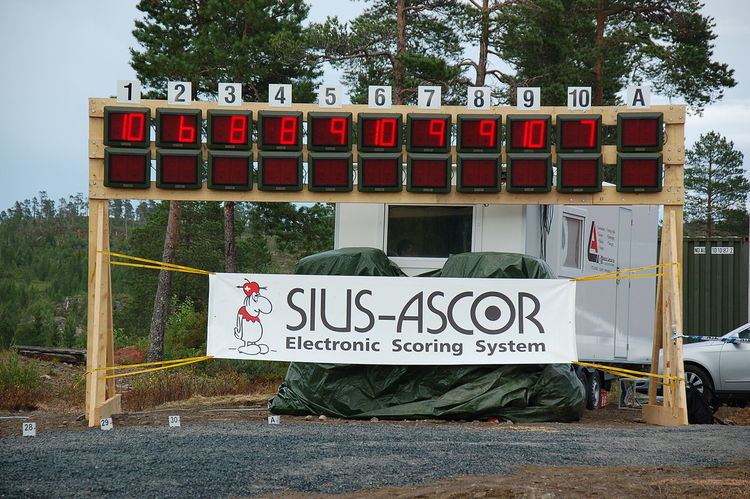 | ||
Electronic scoring systems or electronic targets are automated scoring systems used for sport shooting where the shot placement and score is automatically calculated using electronics and presented on screens to the organizer and shooters. The score may also be shown on a big screen for audience at the shooting range, and this has in many ways revolutionized the shooting sport.
Contents
- Use
- Advantages
- Disadvantages
- Function
- Sound Triangulation
- Light Triangulation
- Data transmission
- Manufacturers
- Open source
- References
With traditional paper targets the audience has to understand the signals used for scoring, and perhaps managed to monitor the scoring of maximum two targets at once, while with electronics the current scores can be shown on big screens only fractions of a second after the shot is fired and the audience can easily see how different shooters compare to each other. Some systems even allow real time publishing on the internet. The scoring can also be held back by the Range Officer until the string of fire is finished, so that scores for each competitor can be shown in ascending order.
Use
Electronic targets are used for all types of sport shooting ranging from 10 meter air rifle to over 1000 meter long range shooting competitions, for "running targets" (moving on rails) like the ISSF 50 meter running target or "Running Moose" competitions (popular in Scandinavia), and electronic knock down targets are also used for sport shooting and by many militaries. Targets are available for calibers ranging from air gun pellets up to the 105 mm tank shell.
Advantages
Some advantages of electronic scoring systems are:
Disadvantages
Some disadvantages of electronic scoring systems are:
Function
All types of electronic targets use some form of trigonometric equations to triangulate the position of bullet impact.
Sound Triangulation
Sound-chamber targets is the oldest type of electronic targets, and uses the Mach wave of the bullet to determine its position as it passes through the target. The first sound-chamber system for big bore rifles was patented in 1975, and was used for the first time in a world championship in 1982.
It functions by using microphones to measure the sound wave of the projectile as it passes through the target. The target is built like a frame and covered with rubber sheets front and back providing an almost tight sound-chamber. Inside the chamber there are microphones, either three in the bottom of the frame, or one in each of the four corners. Additionally, the air temperature inside the target is measured to precisely calculate the speed of sound. To avoid large temperature fluctuations the target is insulated in the front and back using insulating material like for instance styrofoam, and the target seen by the shooter is painted on the insulation material. To keep the sound-chamber somewhat tight, there is an additional rubber liner outside the main rubber liner, which can be turned manually or with an electric motor at certain intervals to avoid the holes in the sound chamber becoming too large.
Light Triangulation
In 2010 Sius Ascor released Laserscore, the first electronic target system using lasers, being able to read with a claimed accuracy of a few hundredths of a millimeter by using three infrared lasers. Since the measuring method is optical and there's no moving parts, the target is almost free from wear and maintenance.
Data transmission
Data can be transferred either wirelessly or through cables. Cables are often used for permanent installations, while wireless radio transmissions are used for targets placed provisionally in the field and for running targets.
Manufacturers
Some well known manufacturers are:
Open source
E-Targ is an open source project with the goal of publishing free research, designs, schematics and software, etc. so that hobbyists can build an electronic target for under 50 USD. The system is supposed to be portable, accurate within 5 mm, plot impact locations quickly and transmit the data wirelessly to a laptop or smartphone. A beta version was presented by Matthew Waterman and Donato Salazar as a school project at the Northern Illinois University in 2011, and from there the plan is to involve others to develop the project further.
The thesis includes building instructions and complete programming, together with a more in depth explanation of the physics and mathematical formulas used, which gives a good foundation for further development. During the project both "soft targets" (targets with a sound chamber) and "hard targets" (without sound chamber) was tested, and hard targets were the most successful giving an electronic precision of 2 cm (.8 inches). To function satisfactorily, E-Targ suggests that the electronic precision should be at least 10 times better than the expected precision of the shooter.
